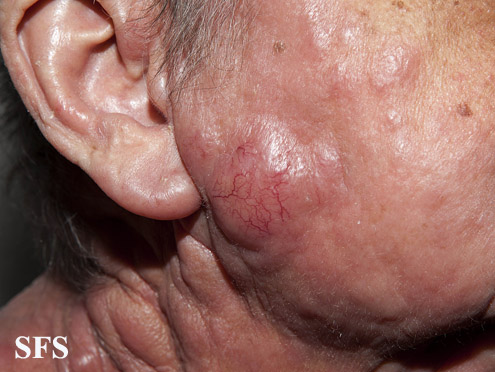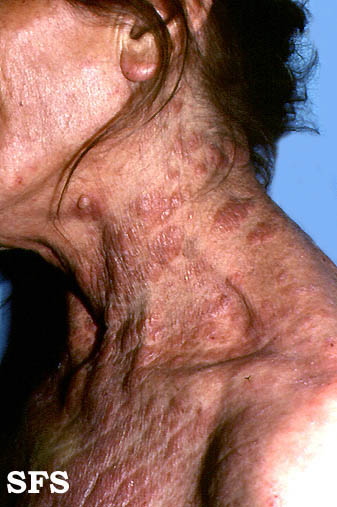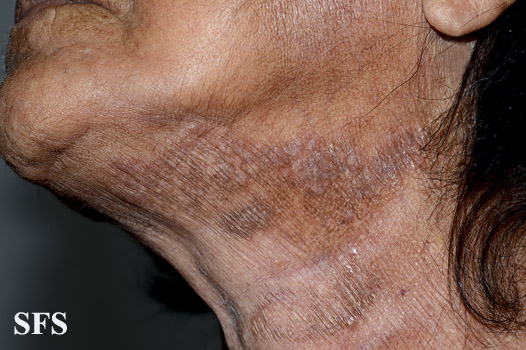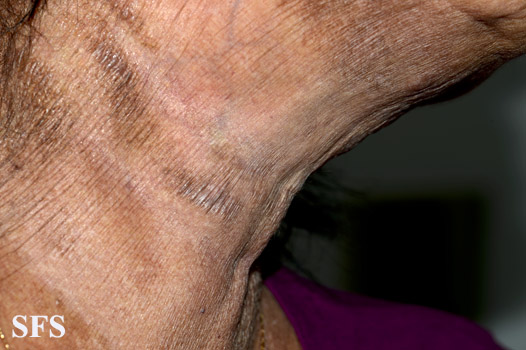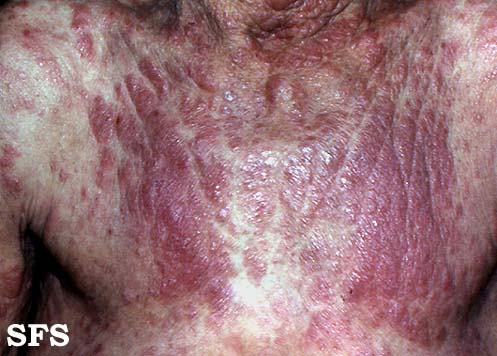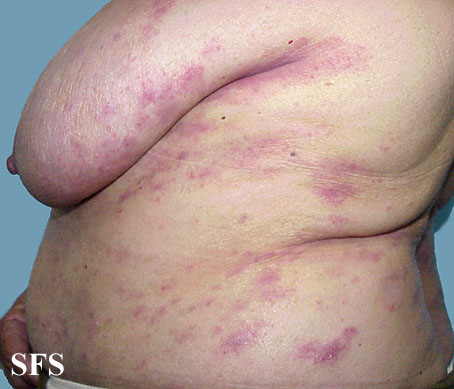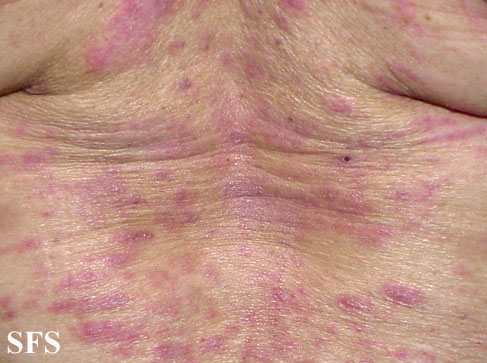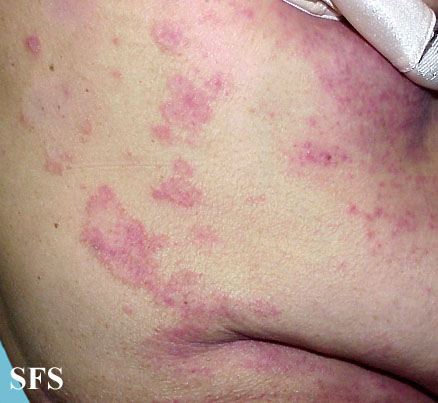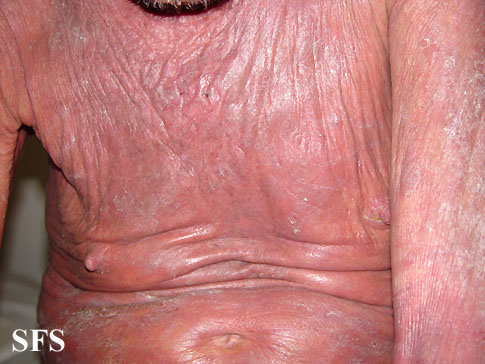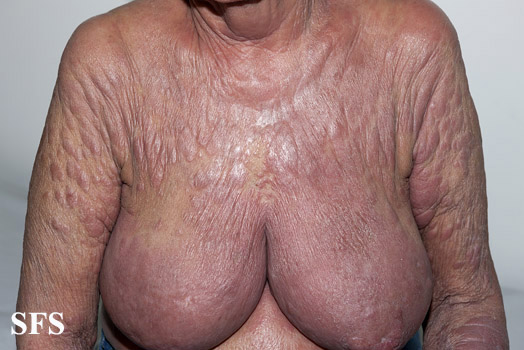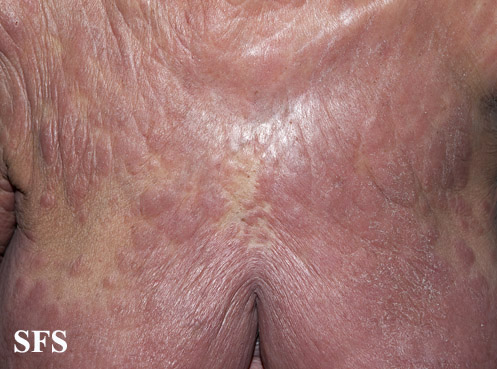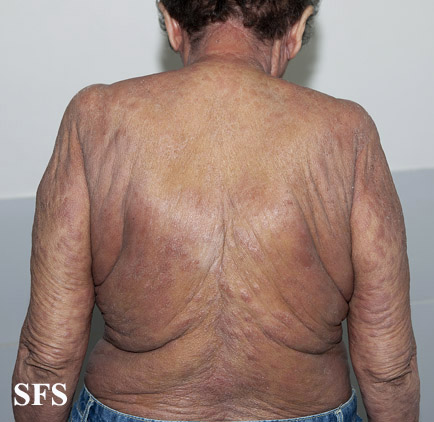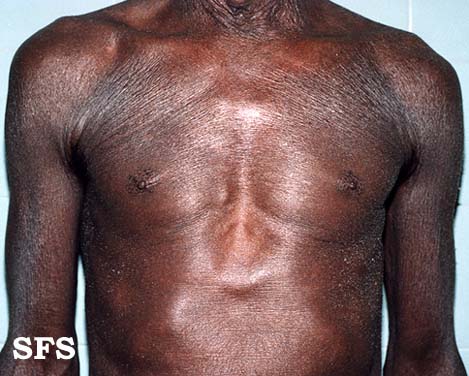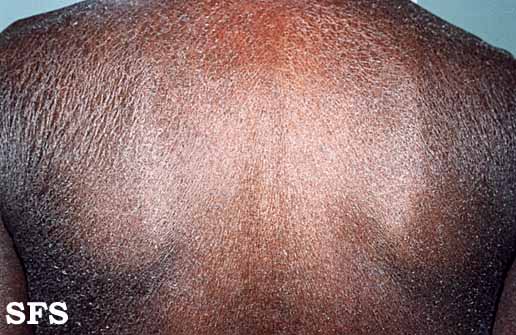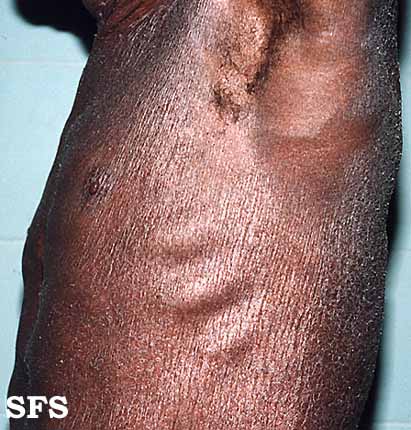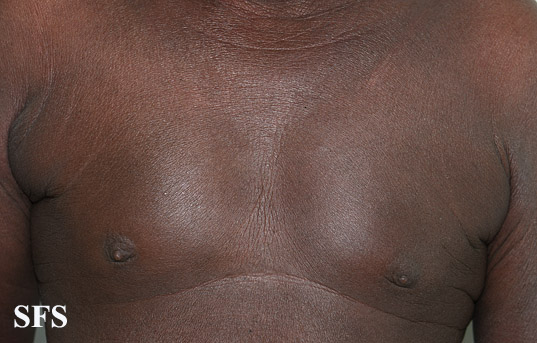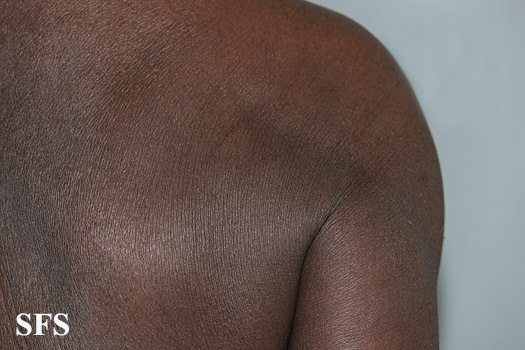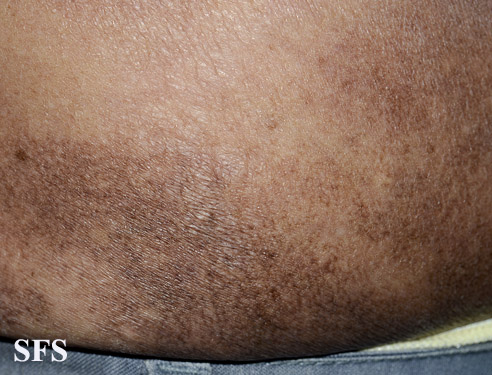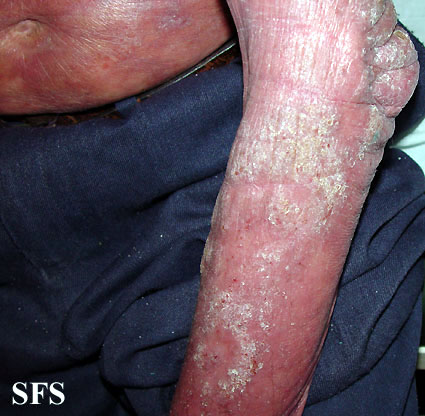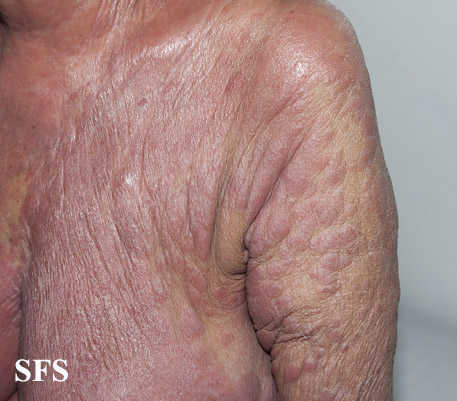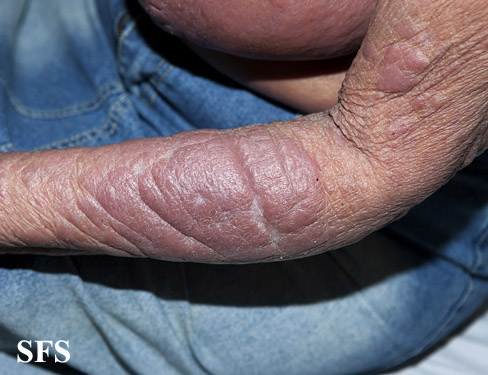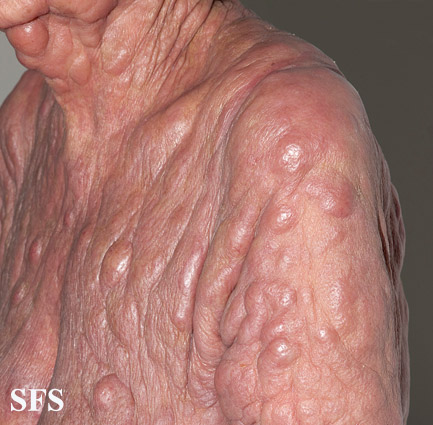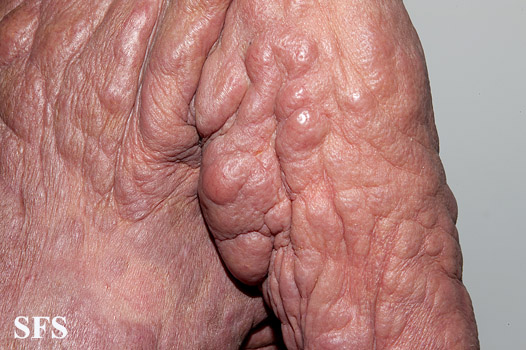Mycosis fungoides physical examination: Difference between revisions
| Line 4: | Line 4: | ||
==Overview== | ==Overview== | ||
Common physical examination findings of cutaneous T cell lymphoma include [[fever]], [[rash]], [[pruritus]], [[ulcer]], chest tenderness, abdomen tenderness, bone tenderness, [[Lymphadenopathy|peripheral lymphadenopathy]], and [[Lymphadenopathy|central lymphadenopathy]]. | Common physical examination findings of cutaneous T cell lymphoma include [[fever]], [[rash]], [[pruritus]], [[ulcer]], chest tenderness, abdomen tenderness, bone tenderness, [[Lymphadenopathy|peripheral lymphadenopathy]], and [[Lymphadenopathy|central lymphadenopathy]]. | ||
==Physical Examination<ref name="seer.cancer">Cutaneous T cell lymphoma. Surveillance, Epidemiology, and End Results . http://seer.cancer.gov/seertools/hemelymph/51f6cf56e3e27c3994bd52f7/ Accessed on January 19, 2016</ref>== | ==Overview== | ||
Patients with [disease name] usually appear [general appearance]. Physical examination of patients with [disease name] is usually remarkable for [finding 1], [finding 2], and [finding 3]. | |||
OR | |||
Common physical examination findings of [disease name] include [finding 1], [finding 2], and [finding 3]. | |||
OR | |||
The presence of [finding(s)] on physical examination is diagnostic of [disease name]. | |||
OR | |||
The presence of [finding(s)] on physical examination is highly suggestive of [disease name]. | |||
==Physical Examination== | |||
Physical examination of patients with [disease name] is usually normal. | |||
OR | |||
Physical examination of patients with [disease name] is usually remarkable for [finding 1], [finding 2], and [finding 3]. | |||
OR | |||
The presence of [finding(s)] on physical examination is diagnostic of [disease name]. | |||
OR | |||
The presence of [finding(s)] on physical examination is highly suggestive of [disease name]. | |||
===Appearance of the Patient=== | |||
*Patients with [disease name] usually appear [general appearance]. | |||
===Vital Signs=== | |||
*High-grade / low-grade fever | |||
*[[Hypothermia]] / hyperthermia may be present | |||
*[[Tachycardia]] with regular pulse or (ir)regularly irregular pulse | |||
*[[Bradycardia]] with regular pulse or (ir)regularly irregular pulse | |||
*Tachypnea / bradypnea | |||
*Kussmal respirations may be present in _____ (advanced disease state) | |||
*Weak/bounding pulse / pulsus alternans / paradoxical pulse / asymmetric pulse | |||
*High/low blood pressure with normal pulse pressure / [[wide pulse pressure]] / [[narrow pulse pressure]] | |||
===Skin=== | |||
* Skin examination of patients with [disease name] is usually normal. | |||
OR | |||
*[[Cyanosis]] | |||
*[[Jaundice]] | |||
* [[Pallor]] | |||
* Bruises | |||
<gallery widths="150px"> | |||
UploadedImage-01.jpg | Description {{dermref}} | |||
UploadedImage-02.jpg | Description {{dermref}} | |||
</gallery> | |||
===HEENT=== | |||
* HEENT examination of patients with [disease name] is usually normal. | |||
OR | |||
* Abnormalities of the head/hair may include ___ | |||
* Evidence of trauma | |||
* Icteric sclera | |||
* [[Nystagmus]] | |||
* Extra-ocular movements may be abnormal | |||
*Pupils non-reactive to light / non-reactive to accommodation / non-reactive to neither light nor accommodation | |||
*Ophthalmoscopic exam may be abnormal with findings of ___ | |||
* Hearing acuity may be reduced | |||
*[[Weber test]] may be abnormal (Note: A positive Weber test is considered a normal finding / A negative Weber test is considered an abnormal finding. To avoid confusion, you may write "abnormal Weber test".) | |||
*[[Rinne test]] may be positive (Note: A positive Rinne test is considered a normal finding / A negative Rinne test is considered an abnormal finding. To avoid confusion, you may write "abnormal Rinne test".) | |||
* [[Exudate]] from the ear canal | |||
* Tenderness upon palpation of the ear pinnae/tragus (anterior to ear canal) | |||
*Inflamed nares / congested nares | |||
* [[Purulent]] exudate from the nares | |||
* Facial tenderness | |||
* Erythematous throat with/without tonsillar swelling, exudates, and/or petechiae | |||
===Neck=== | |||
* Neck examination of patients with [disease name] is usually normal. | |||
OR | |||
*[[Jugular venous distension]] | |||
*[[Carotid bruits]] may be auscultated unilaterally/bilaterally using the bell/diaphragm of the otoscope | |||
*[[Lymphadenopathy]] (describe location, size, tenderness, mobility, and symmetry) | |||
*[[Thyromegaly]] / thyroid nodules | |||
*[[Hepatojugular reflux]] | |||
===Lungs=== | |||
* Pulmonary examination of patients with [disease name] is usually normal. | |||
OR | |||
* Asymmetric chest expansion OR decreased chest expansion | |||
*Lungs are hyporesonant OR hyperresonant | |||
*Fine/coarse [[crackles]] upon auscultation of the lung bases/apices unilaterally/bilaterally | |||
*Rhonchi | |||
*Vesicular breath sounds OR distant breath sounds | |||
*Expiratory wheezing OR inspiratory wheezing with normal OR delayed expiratory phase | |||
*[[Wheezing]] may be present | |||
*[[Egophony]] present/absent | |||
*[[Bronchophony]] present/absent | |||
*Normal/reduced [[tactile fremitus]] | |||
===Heart=== | |||
* Cardiovascular examination of patients with [disease name] is usually normal. | |||
OR | |||
*Chest tenderness upon palpation | |||
*PMI within 2 cm of the sternum (PMI) / Displaced point of maximal impulse (PMI) suggestive of ____ | |||
*[[Heave]] / [[thrill]] | |||
*[[Friction rub]] | |||
*[[Heart sounds#First heart tone S1, the "lub"(components M1 and T1)|S1]] | |||
*[[Heart sounds#Second heart tone S2 the "dub"(components A2 and P2)|S2]] | |||
*[[Heart sounds#Third heart sound S3|S3]] | |||
*[[Heart sounds#Fourth heart sound S4|S4]] | |||
*[[Heart sounds#Summation Gallop|Gallops]] | |||
*A high/low grade early/late [[systolic murmur]] / [[diastolic murmur]] best heard at the base/apex/(specific valve region) may be heard using the bell/diaphgram of the stethoscope | |||
===Abdomen=== | |||
* Abdominal examination of patients with [disease name] is usually normal. | |||
OR | |||
*[[Abdominal distension]] | |||
*[[Abdominal tenderness]] in the right/left upper/lower abdominal quadrant | |||
*[[Rebound tenderness]] (positive Blumberg sign) | |||
*A palpable abdominal mass in the right/left upper/lower abdominal quadrant | |||
*Guarding may be present | |||
*[[Hepatomegaly]] / [[splenomegaly]] / [[hepatosplenomegaly]] | |||
*Additional findings, such as obturator test, psoas test, McBurney point test, Murphy test | |||
===Back=== | |||
* Back examination of patients with [disease name] is usually normal. | |||
OR | |||
*Point tenderness over __ vertebrae (e.g. L3-L4) | |||
*Sacral edema | |||
*Costovertebral angle tenderness bilaterally/unilaterally | |||
*Buffalo hump | |||
===Genitourinary=== | |||
* Genitourinary examination of patients with [disease name] is usually normal. | |||
OR | |||
*A pelvic/adnexal mass may be palpated | |||
*Inflamed mucosa | |||
*Clear/(color), foul-smelling/odorless penile/vaginal discharge | |||
===Neuromuscular=== | |||
* Neuromuscular examination of patients with [disease name] is usually normal. | |||
OR | |||
*Patient is usually oriented to persons, place, and time | |||
* Altered mental status | |||
* Glasgow coma scale is ___ / 15 | |||
* Clonus may be present | |||
* Hyperreflexia / hyporeflexia / areflexia | |||
* Positive (abnormal) Babinski / plantar reflex unilaterally/bilaterally | |||
* Muscle rigidity | |||
* Proximal/distal muscle weakness unilaterally/bilaterally | |||
* ____ (finding) suggestive of cranial nerve ___ (roman numerical) deficit (e.g. Dilated pupils suggestive of CN III deficit) | |||
*Unilateral/bilateral upper/lower extremity weakness | |||
*Unilateral/bilateral sensory loss in the upper/lower extremity | |||
*Positive straight leg raise test | |||
*Abnormal gait (describe gait: e.g. ataxic (cerebellar) gait / steppage gait / waddling gait / choeiform gait / Parkinsonian gait / sensory gait) | |||
*Positive/negative Trendelenburg sign | |||
*Unilateral/bilateral tremor (describe tremor, e.g. at rest, pill-rolling) | |||
*Normal finger-to-nose test / Dysmetria | |||
*Absent/present dysdiadochokinesia (palm tapping test) | |||
===Extremities=== | |||
* Extremities examination of patients with [disease name] is usually normal. | |||
OR | |||
*[[Clubbing]] | |||
*[[Cyanosis]] | |||
*Pitting/non-pitting [[edema]] of the upper/lower extremities | |||
*Muscle atrophy | |||
*Fasciculations in the upper/lower extremity | |||
==References== | |||
{{Reflist|2}} | |||
{{WH}} | |||
{{WS}} | |||
[[Category: (name of the system)]]==Physical Examination<ref name="seer.cancer">Cutaneous T cell lymphoma. Surveillance, Epidemiology, and End Results . http://seer.cancer.gov/seertools/hemelymph/51f6cf56e3e27c3994bd52f7/ Accessed on January 19, 2016</ref>== | |||
===Vital Signs=== | ===Vital Signs=== | ||
* [[Fever]] is often present<ref name="seer.cancer" /> | * [[Fever]] is often present<ref name="seer.cancer" /> | ||
Revision as of 14:34, 12 December 2018
|
Cutaneous T cell lymphoma Microchapters |
Editor-In-Chief: C. Michael Gibson, M.S., M.D. [1]; Associate Editor(s)-in-Chief: Sowminya Arikapudi, M.B,B.S. [2] Jesus Rosario Hernandez, M.D. [3]
Overview
Common physical examination findings of cutaneous T cell lymphoma include fever, rash, pruritus, ulcer, chest tenderness, abdomen tenderness, bone tenderness, peripheral lymphadenopathy, and central lymphadenopathy.
Overview
Patients with [disease name] usually appear [general appearance]. Physical examination of patients with [disease name] is usually remarkable for [finding 1], [finding 2], and [finding 3].
OR
Common physical examination findings of [disease name] include [finding 1], [finding 2], and [finding 3].
OR
The presence of [finding(s)] on physical examination is diagnostic of [disease name].
OR
The presence of [finding(s)] on physical examination is highly suggestive of [disease name].
Physical Examination
Physical examination of patients with [disease name] is usually normal.
OR
Physical examination of patients with [disease name] is usually remarkable for [finding 1], [finding 2], and [finding 3].
OR
The presence of [finding(s)] on physical examination is diagnostic of [disease name].
OR
The presence of [finding(s)] on physical examination is highly suggestive of [disease name].
Appearance of the Patient
- Patients with [disease name] usually appear [general appearance].
Vital Signs
- High-grade / low-grade fever
- Hypothermia / hyperthermia may be present
- Tachycardia with regular pulse or (ir)regularly irregular pulse
- Bradycardia with regular pulse or (ir)regularly irregular pulse
- Tachypnea / bradypnea
- Kussmal respirations may be present in _____ (advanced disease state)
- Weak/bounding pulse / pulsus alternans / paradoxical pulse / asymmetric pulse
- High/low blood pressure with normal pulse pressure / wide pulse pressure / narrow pulse pressure
Skin
- Skin examination of patients with [disease name] is usually normal.
OR
-
Description (Adapted from Dermatology Atlas)
-
Description (Adapted from Dermatology Atlas)
HEENT
- HEENT examination of patients with [disease name] is usually normal.
OR
- Abnormalities of the head/hair may include ___
- Evidence of trauma
- Icteric sclera
- Nystagmus
- Extra-ocular movements may be abnormal
- Pupils non-reactive to light / non-reactive to accommodation / non-reactive to neither light nor accommodation
- Ophthalmoscopic exam may be abnormal with findings of ___
- Hearing acuity may be reduced
- Weber test may be abnormal (Note: A positive Weber test is considered a normal finding / A negative Weber test is considered an abnormal finding. To avoid confusion, you may write "abnormal Weber test".)
- Rinne test may be positive (Note: A positive Rinne test is considered a normal finding / A negative Rinne test is considered an abnormal finding. To avoid confusion, you may write "abnormal Rinne test".)
- Exudate from the ear canal
- Tenderness upon palpation of the ear pinnae/tragus (anterior to ear canal)
- Inflamed nares / congested nares
- Purulent exudate from the nares
- Facial tenderness
- Erythematous throat with/without tonsillar swelling, exudates, and/or petechiae
Neck
- Neck examination of patients with [disease name] is usually normal.
OR
- Jugular venous distension
- Carotid bruits may be auscultated unilaterally/bilaterally using the bell/diaphragm of the otoscope
- Lymphadenopathy (describe location, size, tenderness, mobility, and symmetry)
- Thyromegaly / thyroid nodules
- Hepatojugular reflux
Lungs
- Pulmonary examination of patients with [disease name] is usually normal.
OR
- Asymmetric chest expansion OR decreased chest expansion
- Lungs are hyporesonant OR hyperresonant
- Fine/coarse crackles upon auscultation of the lung bases/apices unilaterally/bilaterally
- Rhonchi
- Vesicular breath sounds OR distant breath sounds
- Expiratory wheezing OR inspiratory wheezing with normal OR delayed expiratory phase
- Wheezing may be present
- Egophony present/absent
- Bronchophony present/absent
- Normal/reduced tactile fremitus
Heart
- Cardiovascular examination of patients with [disease name] is usually normal.
OR
- Chest tenderness upon palpation
- PMI within 2 cm of the sternum (PMI) / Displaced point of maximal impulse (PMI) suggestive of ____
- Heave / thrill
- Friction rub
- S1
- S2
- S3
- S4
- Gallops
- A high/low grade early/late systolic murmur / diastolic murmur best heard at the base/apex/(specific valve region) may be heard using the bell/diaphgram of the stethoscope
Abdomen
- Abdominal examination of patients with [disease name] is usually normal.
OR
- Abdominal distension
- Abdominal tenderness in the right/left upper/lower abdominal quadrant
- Rebound tenderness (positive Blumberg sign)
- A palpable abdominal mass in the right/left upper/lower abdominal quadrant
- Guarding may be present
- Hepatomegaly / splenomegaly / hepatosplenomegaly
- Additional findings, such as obturator test, psoas test, McBurney point test, Murphy test
Back
- Back examination of patients with [disease name] is usually normal.
OR
- Point tenderness over __ vertebrae (e.g. L3-L4)
- Sacral edema
- Costovertebral angle tenderness bilaterally/unilaterally
- Buffalo hump
Genitourinary
- Genitourinary examination of patients with [disease name] is usually normal.
OR
- A pelvic/adnexal mass may be palpated
- Inflamed mucosa
- Clear/(color), foul-smelling/odorless penile/vaginal discharge
Neuromuscular
- Neuromuscular examination of patients with [disease name] is usually normal.
OR
- Patient is usually oriented to persons, place, and time
- Altered mental status
- Glasgow coma scale is ___ / 15
- Clonus may be present
- Hyperreflexia / hyporeflexia / areflexia
- Positive (abnormal) Babinski / plantar reflex unilaterally/bilaterally
- Muscle rigidity
- Proximal/distal muscle weakness unilaterally/bilaterally
- ____ (finding) suggestive of cranial nerve ___ (roman numerical) deficit (e.g. Dilated pupils suggestive of CN III deficit)
- Unilateral/bilateral upper/lower extremity weakness
- Unilateral/bilateral sensory loss in the upper/lower extremity
- Positive straight leg raise test
- Abnormal gait (describe gait: e.g. ataxic (cerebellar) gait / steppage gait / waddling gait / choeiform gait / Parkinsonian gait / sensory gait)
- Positive/negative Trendelenburg sign
- Unilateral/bilateral tremor (describe tremor, e.g. at rest, pill-rolling)
- Normal finger-to-nose test / Dysmetria
- Absent/present dysdiadochokinesia (palm tapping test)
Extremities
- Extremities examination of patients with [disease name] is usually normal.
OR
- Clubbing
- Cyanosis
- Pitting/non-pitting edema of the upper/lower extremities
- Muscle atrophy
- Fasciculations in the upper/lower extremity
References
Template:WH Template:WS==Physical Examination[1]==
Vital Signs
HEENT
Chest Exam
- Thoracic masses suggestive of central lymphadenopathy
- Chest tenderness
Skin
- Generalized erythroderma
- Ulcer
- Rash
- Pruritus
Abdomen
- Abdominal masses suggestive of central lymphadenopathy
- Abdomen tenderness
Extremities
- Peripheral lymphadenopathy
- Bone tenderness
| Name | Description |
|---|---|
| Premycotic (pretumor) phase |
|
| Patch phase |
|
| Plaque phase |
|
| Tumor phase |
|
References
- ↑ 1.0 1.1 Cutaneous T cell lymphoma. Surveillance, Epidemiology, and End Results . http://seer.cancer.gov/seertools/hemelymph/51f6cf56e3e27c3994bd52f7/ Accessed on January 19, 2016
- ↑ Cutaneous T cell lymphoma. Canadian Cancer Society. http://www.cancer.ca/en/cancer-information/cancer-type/non-hodgkin-lymphoma/non-hodgkin-lymphoma/types-of-nhl/cutaneous-t-cell-lymphoma/?region=on Accessed on January 19, 2016

